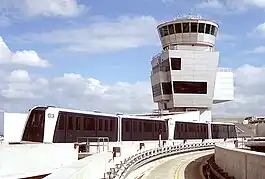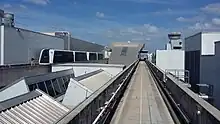| Skytrain | ||||||||||||||||||||||||||||||||||||||||||||||||||||||||||||||||||||||||||||||||||||||||||||||||||||||||||||||
|---|---|---|---|---|---|---|---|---|---|---|---|---|---|---|---|---|---|---|---|---|---|---|---|---|---|---|---|---|---|---|---|---|---|---|---|---|---|---|---|---|---|---|---|---|---|---|---|---|---|---|---|---|---|---|---|---|---|---|---|---|---|---|---|---|---|---|---|---|---|---|---|---|---|---|---|---|---|---|---|---|---|---|---|---|---|---|---|---|---|---|---|---|---|---|---|---|---|---|---|---|---|---|---|---|---|---|---|---|---|---|
 | ||||||||||||||||||||||||||||||||||||||||||||||||||||||||||||||||||||||||||||||||||||||||||||||||||||||||||||||
 Skytrain vehicle near the airport's control tower | ||||||||||||||||||||||||||||||||||||||||||||||||||||||||||||||||||||||||||||||||||||||||||||||||||||||||||||||
| Overview | ||||||||||||||||||||||||||||||||||||||||||||||||||||||||||||||||||||||||||||||||||||||||||||||||||||||||||||||
| Status | Suspended | |||||||||||||||||||||||||||||||||||||||||||||||||||||||||||||||||||||||||||||||||||||||||||||||||||||||||||||
| Owner | Miami-Dade Aviation Department | |||||||||||||||||||||||||||||||||||||||||||||||||||||||||||||||||||||||||||||||||||||||||||||||||||||||||||||
| Locale | Concourse D, Miami International Airport, Miami-Dade County, Florida | |||||||||||||||||||||||||||||||||||||||||||||||||||||||||||||||||||||||||||||||||||||||||||||||||||||||||||||
| Stations | 4 | |||||||||||||||||||||||||||||||||||||||||||||||||||||||||||||||||||||||||||||||||||||||||||||||||||||||||||||
| Service | ||||||||||||||||||||||||||||||||||||||||||||||||||||||||||||||||||||||||||||||||||||||||||||||||||||||||||||||
| Type | People mover | |||||||||||||||||||||||||||||||||||||||||||||||||||||||||||||||||||||||||||||||||||||||||||||||||||||||||||||
| Operator(s) | Crystal Mover Services Inc. | |||||||||||||||||||||||||||||||||||||||||||||||||||||||||||||||||||||||||||||||||||||||||||||||||||||||||||||
| Rolling stock | 20 Crystal Mover cars | |||||||||||||||||||||||||||||||||||||||||||||||||||||||||||||||||||||||||||||||||||||||||||||||||||||||||||||
| Daily ridership | 40,000 (2015) | |||||||||||||||||||||||||||||||||||||||||||||||||||||||||||||||||||||||||||||||||||||||||||||||||||||||||||||
| History | ||||||||||||||||||||||||||||||||||||||||||||||||||||||||||||||||||||||||||||||||||||||||||||||||||||||||||||||
| Opened | September 15, 2010 | |||||||||||||||||||||||||||||||||||||||||||||||||||||||||||||||||||||||||||||||||||||||||||||||||||||||||||||
| Suspended | September 27, 2023 | |||||||||||||||||||||||||||||||||||||||||||||||||||||||||||||||||||||||||||||||||||||||||||||||||||||||||||||
| Technical | ||||||||||||||||||||||||||||||||||||||||||||||||||||||||||||||||||||||||||||||||||||||||||||||||||||||||||||||
| Line length | 0.70 miles (1.12 km) | |||||||||||||||||||||||||||||||||||||||||||||||||||||||||||||||||||||||||||||||||||||||||||||||||||||||||||||
| Track length | 1.61 miles (2.59 km) | |||||||||||||||||||||||||||||||||||||||||||||||||||||||||||||||||||||||||||||||||||||||||||||||||||||||||||||
| Number of tracks | 2 | |||||||||||||||||||||||||||||||||||||||||||||||||||||||||||||||||||||||||||||||||||||||||||||||||||||||||||||
| Character | Fully elevated | |||||||||||||||||||||||||||||||||||||||||||||||||||||||||||||||||||||||||||||||||||||||||||||||||||||||||||||
| Track gauge | 6 ft 27⁄32 in (1,850 mm) | |||||||||||||||||||||||||||||||||||||||||||||||||||||||||||||||||||||||||||||||||||||||||||||||||||||||||||||
| Electrification | 750 V DC | |||||||||||||||||||||||||||||||||||||||||||||||||||||||||||||||||||||||||||||||||||||||||||||||||||||||||||||
| ||||||||||||||||||||||||||||||||||||||||||||||||||||||||||||||||||||||||||||||||||||||||||||||||||||||||||||||
The Skytrain is a people mover at Miami International Airport (MIA) in Miami-Dade County, Florida, United States. One of three people movers at MIA, it operates within Concourse D and connects four stations over a distance of 0.70 miles (1.12 km). It uses Crystal Mover trains, which are fully-automated and travel along the roof of the terminal. The system has transported up to 40,000 passengers daily.
The Skytrain was built as part of an airport expansion project, which included the construction of a new mile-long (1.6 km) terminal. Due to the building's length, the Skytrain built was to facilitate the transport of passengers and reduce walking times. Construction on the new terminal began in 2007 and Skytrain operations began in September 2010.
Due to deterioration of the system's infrastructure, Skytrain service has been suspended indefinitely since September 27, 2023.[1] Service between three of the four stations is expected to resume in March 2024.[2]
Background
The Skytrain was constructed as part of a $3 billion expansion of the North Terminal at Miami International Airport (MIA), a major airline hub for American Airlines. Project planning began in 1998 and ultimately consolidated the four "finger-style" Concourses A, B, C, and D into a single 3.6-million-square-foot (330,000 m2) linear terminal, which became the new Concourse D.[3] To ease connections in the new facility, a people mover system was implemented to transport passengers along the terminal's roof. It was designed to decrease walking times by 70 percent for domestic passengers and 34 percent for international passengers.[4] The trains were built in Japan by Mitsubishi Heavy Industries (MHI) and Sumitomo Corporation and were completed in 2005.[5] Construction on the new terminal began in March 2007; it was built by the joint venture of Parsons–Odebrecht, who also constructed the Skytrain stations and infrastructure.[6] The total cost of the system was $130 million (equivalent to $171 million in 2022).[7][8] It began operations on September 15, 2010.[9]
Service
The Skytrain travels across Concourse D and serves passengers in the airside zone who have cleared airport security.[10] The North Terminal building that houses Concourse D is one mile (1.6 km) long with 50 gates, numbered D1 to D60. The Skytrain route runs for 0.70 miles (1.12 km), beginning at Station 1 on the east side of the concourse near Gate D17, and travels west to Station 4 on the opposite end of the concourse near Gate D47.[11] The two intermediate stations include Station 2, which connects to the baggage claim and terminal exit, and Station 3, which connects to Concourse E in the Central Terminal and passport control for international arrivals.[4][12] Stations are located on the fifth level of the concourse and can be accessed by elevator or escalator from the departures area on the second level.[13]
| Station | Location | Connections | Coordinates |
|---|---|---|---|
| 1 | Near Gate D17 |
|
25°47′53″N 80°16′26″W / 25.79806°N 80.27389°W |
| 2 | Near Gate D24 |
|
25°47′50″N 80°16′36″W / 25.79722°N 80.27667°W |
| 3 | Near Gate D30 |
|
25°47′50″N 80°16′47″W / 25.79722°N 80.27972°W |
| 4 | Near Gate D47 |
|
25°47′52″N 80°17′01″W / 25.79778°N 80.28361°W |
Trains are fully-automated and operate 19 hours a day, from 5:00 am until midnight. Four trains are in service during rush hours from 8:00 am to 8:00 pm, with two or three trains in operation at other times.[14] The headway between trains is two to three minutes, and travel time along the entire route is four minutes.[15] By contrast, walking the length of the concourse between the two farthest gates takes about 30 minutes.[1]
Technology

Track infrastructure is entirely elevated along the roof of Concourse D and is supported by over 100 concrete piers.[7][16] It includes a double-track railway with concrete fixed guideways, which have a track gauge of 6 ft 27⁄32 in (1,850 mm). The entire system includes 1.61 miles (2.59 km) of track.[17] The four stations have an island platform layout with platform screen doors. The system's maintenance and storage center is located adjacent to Station 3.[10]
Rolling stock includes 20 Crystal Mover cars, which are configured into five trains with four cars each, including two fixed married-pair vehicles. The two separate vehicles in each train allows for secure transport of passengers arriving from international flights to the passport control facility; these passengers travel exclusively in the vehicle on the east side of the train, and board and alight the vehicle using a separate lobby on the east side of each station.[10][18] A single car is 38 feet 7 inches (11.75 m) long and 8 feet 10 inches (2.69 m) wide; it can accommodate up to 93 passengers, including eight seats and two spaces for wheelchairs, in compliance with the Americans with Disabilities Act. Up to four trains are put into operation simultaneously, with at least one kept in standby. The trains use rubber tires and can accelerate or decelerate at a rate of 3.2 ft/s2 (0.97 m/s2), with a maximum speed of 50 miles per hour (80 km/h). They are powered by a 750 V DC electrical system and feature electronically controlled pneumatic brakes with regenerative braking.[10] Plans to purchase two additional four-car trains were approved in 2022,[19][20] and are scheduled to be implemented by early 2026.[21]

As a medium-capacity rail system, the Skytrain can transport up to 9,000 passengers per hour per direction,[10] and it served up to 40,000 passengers daily in 2015.[22] It is one of three individual people mover systems at MIA,[23] in addition to the Concourse E people mover (opened in 1980) and the MIA Mover (opened in 2011).[24][25] Since its opening in 2010, Skytrain operations and maintenance (O&M) have been provided under contract by Crystal Mover Services Inc. (CMSI), a joint subsidiary of MHI and Sumitomo Corporation. The Miami-Dade Aviation Department (MDAD), which owns the airport and the Skytrain, renewed CMSI's contract in 2022 to continue O&M services for an additional five years.[20]
In 2011, MDAD received an "Award of Merit" from Engineering News-Record (ENR) for the construction of the Skytrain and the North Terminal's Regional Commuter Facility; it was awarded in ENR's annual "Best Projects" competition for construction projects in the Southeastern United States.[16][26]
Incidents
On December 22, 2015, a train collided with the buffer stop at the end of the track at Station 4 during an overnight maintenance test. The lead vehicle derailed onto the roof of the concourse, while the rear vehicle remained on the track. Only one employee was on board at the time and no injuries were reported. Passenger service was suspended for investigation, and the cause of the accident was ultimately determined to be the result of a short circuit which disabled the train's braking system. The circuiting was modified to remove the brake bypass function during normal train operations, and passenger service resumed on December 26.[27][28]
Skytrain service has been suspended since September 27, 2023, due to structural damage in the system's infrastructure.[1] Engineers discovered extensive cracking due to "accelerated deterioration" of the concrete in three of the piers under the tracks near Station 1 and recommended an immediate closure of the system.[7] The cracking had previously been identified by engineers during routine inspections in 2021, but the issues were determined to be "minor" at the time. To supplement the lack of train service, American Airlines increased golf cart shuttle service inside the councourse, and MIA began operating a shuttle bus service between Gates D10 and D55 from 9:00 am to 2:00 pm.[11] In January 2024, it was announced that the first phase of repairs is expected to be completed by March, after which train service will resume between Stations 2, 3, and 4.[2]
See also
References
- 1 2 3 "MIA's Skytrain is temporarily out of service due to maintenance". NBC 6. September 27, 2023. Archived from the original on December 5, 2023. Retrieved October 9, 2023.
- 1 2 Hanks, Douglas (January 10, 2024). "Miami airport's grounded Skytrain should be rolling again in weeks, director says". Miami Herald. Retrieved January 14, 2024.
- ↑ Richard, Militza (February 2010). "Miami International Airport: An Entirely New Facility" (PDF). Supply Chain. Bizclik Media. Archived (PDF) from the original on July 12, 2017. Retrieved November 12, 2023 – via Miami International Airport.
- 1 2 Financial Planning & Performance Analysis Division. "Overview". Fiscal Year 2022 Adopted Budget (PDF) (Report). Miami-Dade Aviation Department. p. 17. Archived (PDF) from the original on November 9, 2023. Retrieved November 9, 2023.
- ↑ Clark, Cammy (December 25, 2015). "Skytrain sets faster pace". Miami Herald. p. 2A. Archived from the original on October 29, 2023. Retrieved November 12, 2023 – via Newspapers.com.
- ↑ "North Terminal Development Consolidation Project Phase 1, Miami". Engineering News-Record. January 1, 2011. Archived from the original on October 12, 2023. Retrieved October 17, 2023.
- 1 2 3 Hanks, Douglas (September 27, 2023). "'Extensive structural cracking' closed MIA's Skytrain. That means a mile walk for many". Miami Herald. Archived from the original on October 13, 2023. Retrieved October 9, 2023.
- ↑ Johnston, Louis; Williamson, Samuel H. (2023). "What Was the U.S. GDP Then?". MeasuringWorth. Retrieved November 30, 2023. United States Gross Domestic Product deflator figures follow the Measuring Worth series.
- ↑ Myers, Gay Naygle (September 16, 2010). "Skytrain opens at Miami's airport". Travel Weekly. Archived from the original on October 12, 2023. Retrieved October 9, 2023.
- 1 2 3 4 5 Hirasawa, Toshio; et al. (March 2009). ""Crystal Mover" Automated People Mover for Miami International Airport" (PDF). Mitsubishi Heavy Industries Technical Review. Vol. 46, no. 1. Mitsubishi Heavy Industries. pp. 23–25. Archived (PDF) from the original on November 26, 2023. Retrieved October 16, 2023.
- 1 2 Hanks, Douglas (October 20, 2023). "Skytrain update: Miami airport planning bus trips to make up for suspended train service". Miami Herald. Archived from the original on December 5, 2023. Retrieved October 26, 2023.
- 1 2 "Riding the Skytrain". Miami International Airport. Archived from the original on March 23, 2023. Retrieved November 14, 2023.
- ↑ Miami International Airport (Interactive map). Atrius Maps. 2023. § Main Terminal. Archived from the original on November 13, 2023. Retrieved October 10, 2023 – via American Airlines.
- ↑ Chinea, Eddie; Lea & Elliott, Inc. (August 2021). "Appendix 2: North Terminal Skytrain APM System". APM Access / Adjacent Work Requirements (AAWR) (PDF) (Report). Miami-Dade Aviation Department. p. 16. Archived (PDF) from the original on October 31, 2023. Retrieved October 18, 2023.
- ↑ McCormick, Carroll (January–February 2011). "Completing Miami's CIP" (PDF). Airports International. Vol. 44, no. 1. Key Publishing. p. 5. Archived (PDF) from the original on October 26, 2023. Retrieved October 16, 2023 – via Miami International Airport.
- 1 2 "Miami Airport Skytrain and Regional Commuter Facility, Miami". Engineering News-Record. November 7, 2011. Archived from the original on November 11, 2023. Retrieved November 12, 2023.
- ↑ North Terminal Development: Program Fact Sheet (PDF) (Fact sheet). Miami-Dade Aviation Department. September 11, 2013. 913R. Archived (PDF) from the original on July 12, 2017. Retrieved November 13, 2023.
Track length: 8,500 LF
- ↑ "'Crystal Mover' Automated People Mover System in Operation at Miami International Airport's North Terminal" (PDF). Mitsubishi Heavy Industries Technical Review. Vol. 48, no. 1. Mitsubishi Heavy Industries. March 2011. pp. 41–42. Archived (PDF) from the original on December 5, 2023. Retrieved October 18, 2023.
- ↑ Finance & Strategy Division (May 10, 2023). "Introductory Section: Major Initiatives and Long-Term Financial Planning". 2022 Annual Comprehensive Financial Report (PDF) (Report). Miami-Dade Aviation Department. p. vi. Archived (PDF) from the original on November 9, 2023. Retrieved November 9, 2023.
- 1 2 Burroughs, David (March 2, 2022). "Miami airport APM operation and maintenance contract renewed". International Railway Journal. Archived from the original on November 16, 2023. Retrieved November 16, 2023.
- ↑ Facilities Development Division (September 25, 2023). CIP Schedule (PDF) (Gantt chart). Miami-Dade Aviation Department. p. 2. Archived (PDF) from the original on November 12, 2023. Retrieved November 12, 2023.
- ↑ Smiley, David (December 25, 2015). "Skytrain on hold after derailment". Miami Herald. p. A5. Archived from the original on November 20, 2023. Retrieved November 12, 2023 – via Newspapers.com.
- ↑ "Miami International Airport builds for the future". Airports of the World. Key Publishing. August 22, 2019. Archived from the original on November 19, 2023. Retrieved November 19, 2023 – via Key.Aero.
- ↑ "1.7 Operation and Maintenance of the APM System". Railroad Accident Report: Miami International Airport, Automated People Mover Train Collision with Passenger Terminal Wall, Miami, Florida, November 28, 2008 (PDF) (Report). National Transportation Safety Board. November 8, 2011. p. 10. NTSB/RAR-11/01. Archived (PDF) from the original on October 31, 2023. Retrieved October 22, 2023.
- ↑ Gerber, Greg (October 2011). "Miami Int'l Debuts $270 Million People Mover". Airport Improvement. Chapel Road Communications. Archived from the original on October 31, 2023. Retrieved October 22, 2023.
- ↑ Judy, Scott (November 7, 2011). "ENR Southeast Recognizes the Region's Best". Engineering News-Record. Archived from the original on September 27, 2023. Retrieved November 12, 2023.
- ↑ Giménez, Carlos A. (May 27, 2016). Report on the People Mover Derailment at Miami International Airport – Directive 160449 (PDF) (Memorandum). Miami-Dade County. Archived (PDF) from the original on February 15, 2017. Retrieved November 12, 2023.
- ↑ Ramos, Domingo (December 26, 2015). "Skytrain reopens after derailment at Miami International Airport". Local 10. Archived from the original on August 12, 2017. Retrieved October 10, 2023.